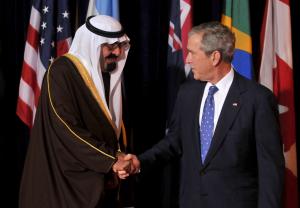Many expect a smoking gun to be found in the 28 still-classified pages of the official 9/11 Commission Report, evidence linking Saudi Arabia to Al Qaeda. The truth about the Kingdom’s links to the Global Jihadi Movement is historic and already established.
Again this week, there were calls to declassify the missing sections of the 9/11 Commission report. This time, the pressure comes from relatives of the 9/11 victims, who have brought a court case alleging that a charity linked to the government of Saudi Arabia was funneling funds to Osama bin Laden and Al Qaeda. The revelation of official statements made last year by the so-called “20th hijacker,” Zacarias Moussaoui have given the accusations more credence. You can read the transcripts of his depositions here, here, here, and here.
Over the years, Moussaoui has made serial claims about Al Qaeda’s international links and plots beyond the 9/11 attacks, including a plan to down Air Force One with a Stinger missile. Now, he accuses members of the Saudi royalty of being financiers of Osama bin Laden and his organization. Unsurprisingly, the official response from the Saudi government has been swift and dismissive, with the embassy in Washington, D.C. stating that “Moussaoui is a deranged criminal” and that “His words have no credibility.”
Those who expect some kind of resolution or spectacular revelation will likely be disappointed even if the redacted portions of the Commission report are released. As has been documented, a wide range of Moussaoui’s stories in the past have been demonstrated to be not only questionable but even impossible. It should be remembered that back in 2006 he was diagnosed as suffering from paranoid schizophrenia. Even if he no longer suffers from mental illness, his latest statements may be just another pedestrian case of a “lifer” bargaining testimony for concessions.
The truth about the Kingdom’s connections to the international jihadist movement are in fact much older and well documented.
To begin with, the Kingdom was actually created out of the pact made between Mohammad bin Saud and the fundamentalist religious leader Mohammad ibn Abd al-Wahhab, the founder of the puritanical version of Sunni Islam know as Wahhabism. Subsequently, the nation that resulted was one defined in stark contrast to enlightened modern monarchies such as the Hashemite Kingdom of Jordan or secular Muslim republics such as Ataturk’s Turkey. But the definitive connection between the House of Saud and the Global Jihadist Movement can be traced back to 1979. In a year that would see the Soviets invade Afghanistan and catalyze a Holy War against themselves, and a theocratic revolution erupt in Iran, 500 jihadi terrorists stormed the holiest site in Islam, the Grand Mosque in Mecca. Their leader, Juhayman al Otaybi, launched the assault because of his belief that Islam had lost its way, that Muslims were weak because they had become unfaithful, and their leaders, starting with King Khalid bin Abdulaziz Al Saud had become un-Islamic.
Eventually, the siege was broken with the help of French counterterrorism operators that had been smuggling into the Kingdom and “converted” to Islam so they could enter Mecca. However, when the king found out that Saudi clerics, members of the learned ulema, had endorsed this holy war against him and his royal house, the king made a deal with the jihadist clerics. In exchange for Saudi Arabia being kept free from jihadist ideologically internally, his regime would support the export and dissemination of Jihadism outside of Saudi Arabia, to non-Muslim lands. For chapter and verse see the excellent book The Siege of Mecca. As a result, for several decades, the Saudi government facilitated the growth internationally of jihadist ideology, be it through Arab Mujahedeen in Afghanistan, or the Balkans, or elsewhere, until the First Gulf War. When the then-king invited “infidel” US troops to station themselves on the Arabian peninsula, Osama bin Laden added the House of Saud onto his target list, despite being born a Saudi Arabian and his father being very close to the royal family. For bin Laden, the House of Saud had become false Muslims, just as in the eyes of the original Meccan raiders on 1979. This has all been well-documented, most especially in Lawrence Wright’s Pulitzer Prize-winning book The Looming Tower. When we sent troops to the land of Mecca and Medina, Al Qaeda reinvented itself as an organization that would not only kill infidels, but also apostate or “false” Muslims, including a campaign after 9/11 that targeted the Saudi security services and government officials.
In recent years, especially with the rise of The Islamic State, Saudi Arabia has fundamentally reassessed its attitude to the Global Jihadist Movement. That does not mean, of course, that all its princes or government officials are whole-heartedly on the side of America and her allies, but it does mean that events such as the recent immolation of the Jordanian pilot Muadh al Kasasbeh have a much greater significance for the Islamic governments of the region.
Sebastian Gorka PhD. is the Major General Matthew C. Horner Distinguished Chair of Military Theory at the Marine Corps University. You can follow him of Twitter at @SebGorka.

COMMENTS
Please let us know if you're having issues with commenting.